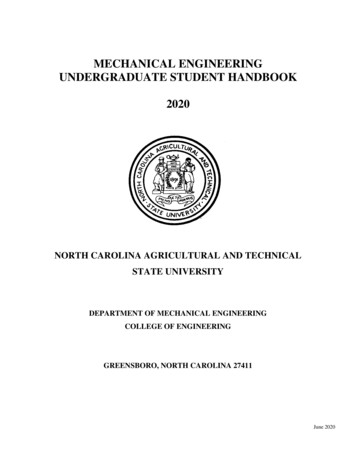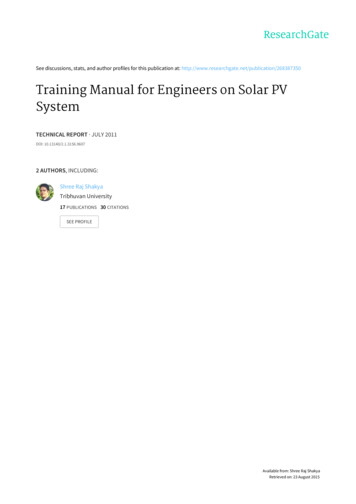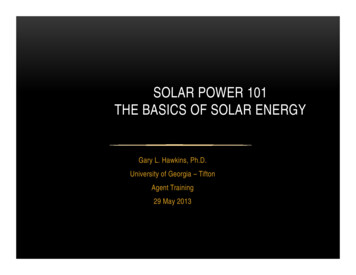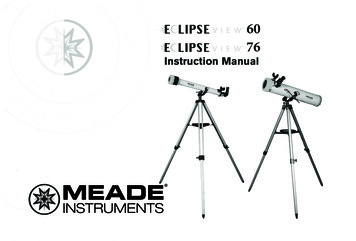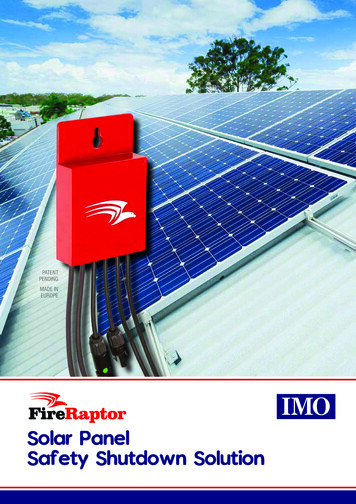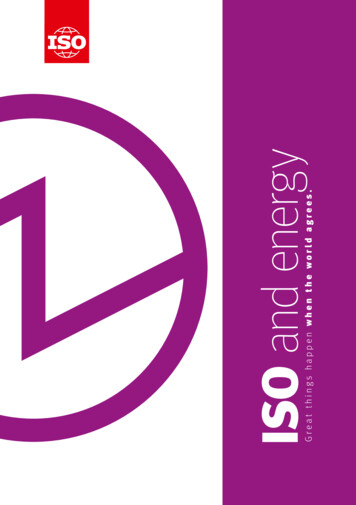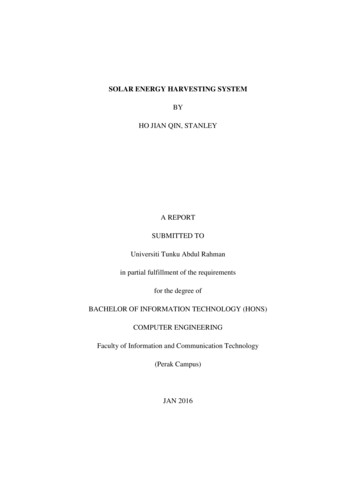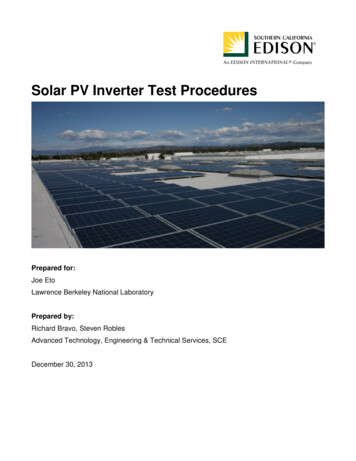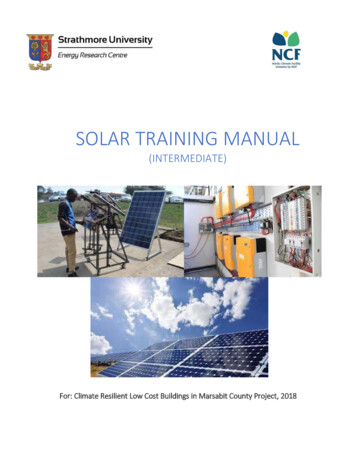
Transcription
SOLAR TRAINING MANUAL(INTERMEDIATE)For: Climate Resilient Low Cost Buildings in Marsabit County Project, 2018
ContentsElectrical Basics . 2THE SUN AS AN ENERGY SOURCE . 5Basics of a Solar System . 7PV Module . 8Battery . 9Charge controller. 111 Page
Electrical BasicsCurrentElectricity flow can be compared to water flow. The higher the electrical flow, the higher thecurrent flow. Current is the quantity of electrons flowing inside wires (conductors) Symbol:‘I’Unit: ‘A’(ampere)VoltageVoltage is the electrical potential, or the pressure that moves electrons through the wires(conductors) and can be compared to pressure in a water pipe. Voltage is the electric potentialdifference between two points Symbol: ‘V’Unit: ‘V’(voltage)Resistance Resistance limits the flow of electrons through the wires, like a nozzle restricts theflow of water through a pipe Smaller pipes restrict water flow, just like smaller wires restrict electrical flow(higher resistance) Longer pipes also restrict water flow. Similarly, the longer the wires, the higher theresistanceResistance is the opposition to the passage of an electric current Symbol: ‘Ω’Unit: ‘Ohms’Ohms lawCurrent, Voltage and Resistance are related and if you know any two you can calculate the third.2 Page
(Mikl, 2014)(Mikl, 2014)Power Power can be thought of as a stream of water, which has both pressure and flow ratePower is derived from voltage (V) multiplied by current (I)P VxISymbol: ‘P’ and Unit: ‘W’(watt)Power Law(Mikl, 2014)(Mikl, 2014)Power & Energy The W (Watt) is a measure of power and it is the rate at which energy is generated orconsumed.The Wh(Watt-hour) is the (integrated) power that is generated or consumed in one hourWhen a 1 kW appliance is used for one hour, the energy used is 1 kWh3 Page
(Mikl, 2014)If the 20W module is used to charge a battery for 5 hours per dayTotal energy generated per day is 20 W * 5 hours 100 Watt-hours (Wh)Parallel and series connections(Mikl, 2014)4 Page
Alternating Current (AC) & Direct Current (DC)AC current is a specific type of electric current in which the direction of the current's flow isreversed, or alternated, on a regular basis. Direct current is no different electrically fromalternating current except for the fact that it flows in the same direction at all times.The Sun As An Energy Source The central star in our planetary system has 330,000 times the mass of the earth and itscore pressure equals 200 billion earth atmospheres.For the next 4.5 billion years every second 560 million tons of hydrogen will be fusionedinto lighter helium. The loss of mass creates an energetic power of 3.85 x 1026 W(E mc2)).The portion of solar energy which reaches the outer parts of the earths atmosphere in arectangular angle is called solar constant.The solar constant at the outer earth atmosphere averages per year at approx. 1,037W/m2.About 1,000W/m2 of this power reach the earths surface.The energy accumulated by this radiation lies between 2,200kWh/m2 at the equator and800kWh/m2 at the polar circles.Basics of PV solar systemSolar Radiation Power produced by PV arrays is directly proportional to sunlight intensityThe sunlight intensity on PV array is dictated by cloud cover and array orientationCloud cover decreases sunlight intensity and diffuses sunlightArray orientation (tilt angle and azimuth angle) impacts the extent of direct and diffuselights reaching the PV arrayIrradiance: Direct/Diffuse Ration & InstallationDirect/diffuse ration dictates tilt or tracking installation5 Page
(Mikl, 2014)Solar resourceIrradiance is power (unit: watt/m2); irradiation is energy (unit: watt-hour/m2/day or watthour/m2/year). Solar irradiance is the sun’s radiant energy incident on a surface of unit areaexpressed in units of kW/m2. Diffuse could be considered “scattered” light; direct light is nonscattered light reaching the device directly from the sun. Peak sun is the irradiance when it is1000 W/m2; peak sun hours are equivalent to the number of hours that the solar irradiance wouldbe at a peak level/power of 1kW/m2Solar Irradiation or Insolation (kWh/m2)Solar irradiation (energy) or solar insolation is equal to total solar irradiance (power) over time.Solar irradiation is the sun’s radiant energy incident on a surface of unit area expressed in unitsof kWh/m2 expressed on an average daily basis for a given month or yearreferred to as solar insolation or peak sun hoursPeak sun hours (PSH) is the average daily amount of solar energy received on a surface. PSHare equivalent to the number of hours that the solar irradiance would be at a peak level/power of1 kW/m2. 1000 W/m2 is a typical average globally at noon on a clear day. Modules are rated at1000 W/m2.PV Array OrientationThe orientation of PV arrays is defined by two angles with respect to the PV surface6 Page
The PV array azimuth angle represents the angle between true north and the directionthe array faces (in Nairobi, magnetic north is 0-3 west of true north).The PV array tilt angle represents the angle the array surface makes with the horizontalplane/earth.Tilt Angle The correct tilt angle should be determined based on the energy usage and the localweather conditions at different times of the yearA tilt angle at less than 10o -is typically not recommended to allow for self cleaning(soiling losses).The self cleaning ability of solar panels starts at a tilt angle of 25 . Higher tilting anglesare usually sufficient for the ability to self cleaning.Basics of a Solar System(Manual for Solar PV training, 2009)Features of Solar PV System PV ModuleCharge controller7 Page
BatteryInverterPV ModuleTypes of PV modules MonocrystallinePolycrystallineAmorphous(Manual for Solar PV training, 2009) 1.2.3.4.5. All PV modules must be marked with the following information (if not, then theymight not be from a reputable source):Open-circuit voltage (Voc)Short-circuit current (Isc)Operating voltage (Vmp)Operating current (Imp)Maximum power (Pmp)Polarity of terminalsMaximum permissible system voltageInfluence of Radiation IntensityThe biggest influence on the power output of a solar panel is naturally caused by the variation ofsun light. The biggest effects happen in the changes of the panels current. A fifty percentdecrease of solar irradiation also causes a fifty percent decrease of ISC. VOC only decreases by afew volts.8 Page
(Mikl, 2014)Temperature InfluenceLike all semiconductors photovoltaic cells are strongly temperature dependent. Highertemperatures can minimize voltage values while low ambient temperatures lead to a higher VOC.(Mikl, 2014)Battery– Battery stores electrical energy in DC– Mainly used during night time and charged during the day.Unit cell for a battery is 2V. Which is the nominal voltage. Voltage range is around 1.85V to2.40V 12V battery has 6 unit cells in series connected.6V battery has 3 unit cells in series connected.9 Page
The main type of battery used in Solar PV systems are the Lead Acid type and they can either beflooded type of the maintenance free type.CapacityCapacity is a measure of the stored electric charge or stored energy that a battery can deliverunder specified conditions An ampere-hour (Ah) is the unit measurement of battery energy storage capacity, andequals to the transfer of one ampere for one hour.Capacity depends on the battery temperature, discharge rate and cut-off voltage.How to read capacity 960Ah at 24h discharge rate [ 960Ah (C/24) ]. 40A can be discharged for 24hours tillvoltage becomes 1.85V/cell1200Ah at 120h discharge rate [ 1200Ah (C/120) ]. 10A can be discharged for 120hourstill voltage becomes 1.85V/cell(Manual for Solar PV training, 2009)(Manual for Solar PV training, 2009)Technical maintenance of batteries Maintain electrolyte level ( use distilled water only).Maintain homogenous electrolyte (Avoid stratification)- acid tends to accumulate inbottom areas, simple shaking could be done.Maintain healthy electrode (Avoid sulfation). Very common in case of no chargecontroller and due to over discharging of the battery of leaving the battery uncharged .Crystallized sulfation covers the surface of electrode permanently.Maintain equal cell voltage ( periodical equalization). Normally automatic by chargecontroller.10 P a g e
Charge controllerThe charge controller is the central equipment of a DC coupled PV stand-alone system. Its maintasks are1. Overcharge protection by automated disconnection2. Reverse current protection3. Controlled recharging and continuous charge hold5. Deep discharge protection11 P a g e
Solar irradiation (energy) or solar insolation is equal to total solar irradiance (power) over time. Solar irradiation is the sun’s radiant energy incident on a surface of unit area expressed in units of kWh/m2 expressed on an average daily basis for a given month or year referred
